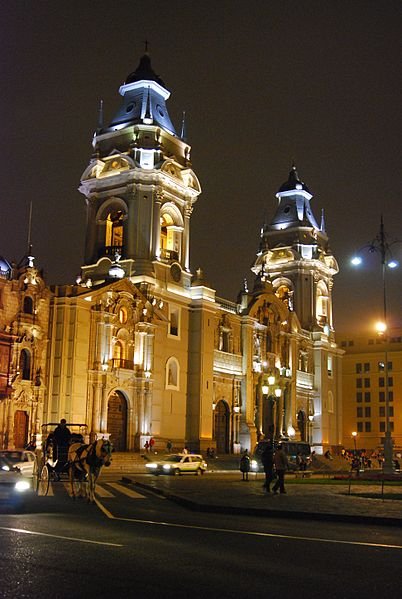 Catedral de Lima
Catedral de LimaSource: https://commons.wikimedia.org/wiki/File:Catedral_de_lima2.jpg
Author: Martin Garcia

Lima is the capital and most populous city in Peru. Located on the Pacific coast in central Peru, Lima covers 2,672.3 sq km (1,031.8 sq mi) and has a population of 7.6 million people. It is five hours behind Coordinated Universal Time (UTC-5).
Lima is located on the Peruvian coastal plain. The Rímac and Lurín rivers flow through it. The city is within a valley the slopes all the way to the coast. The highest point within the Lima city limits is 1,548 m (5,079 ft) above sea level.
Lima's climate can be classified as subtropical or cool desert. The summers here are warm and humid while winters are cool with often gray skies. Warmest month is February, when the average high temperature reaches 26.5°C (79.7°F). Coldes months are August and September, with the3 average low temperature dipping to 14.6°C (58.3°F). Lima is extremely arid. Its annual rainfall is just 13 mm (0.5 in).
The history of Lima goes back to pre-Columbian times, when the area was inhabited by indigenous American tribes. By the 15th century, these tribes have been subdued and absorbed into the Inca Empire. The Inca Empire was defeated by Spanish conquistador Francisco Pizarro, who was then made the governor of the land. Pizarro founded Lima, though originally he called it Ciudad de los Reyes, meaning "City of the Kings".
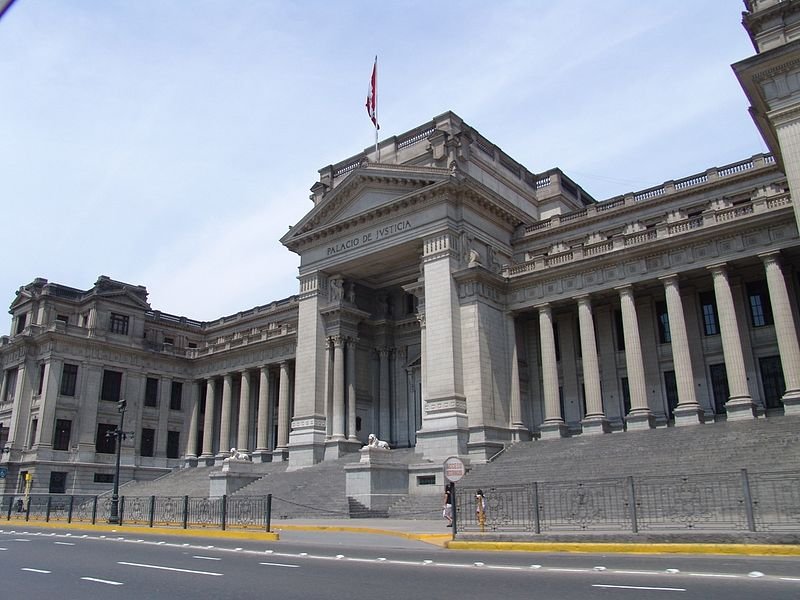 Palacio de Justica de Perú in Lima
Palacio de Justica de Perú in LimaSource: https://commons.wikimedia.org/wiki/File:Palaciojusticiaperu.jpg
Author: And2000

As Lima grew in importance, it was made the capital of the Viceroyalty of Peru in 1543. Even as it continued to expand, Lima faced threats from pirates, which necessitated the construction of city walls. However the earthquake of 1687, which brough widespread devastation to the city, deflated its growth amidst rising competition from other South American cities, particularly Buenos Aires.
The 1820's was a turbulent time for Peru. Menaced by Argentina and Chile, Viceroy José de la Serna evacuated the city. Fearing a populat uprising, the city council of Lima invited the Argentinian and Chilean leader General José de San Martín into the city and signed a Declaration of Independence from Spain at his request. What followed was a war of independence with Spain, economic stagnation and political turmoil.
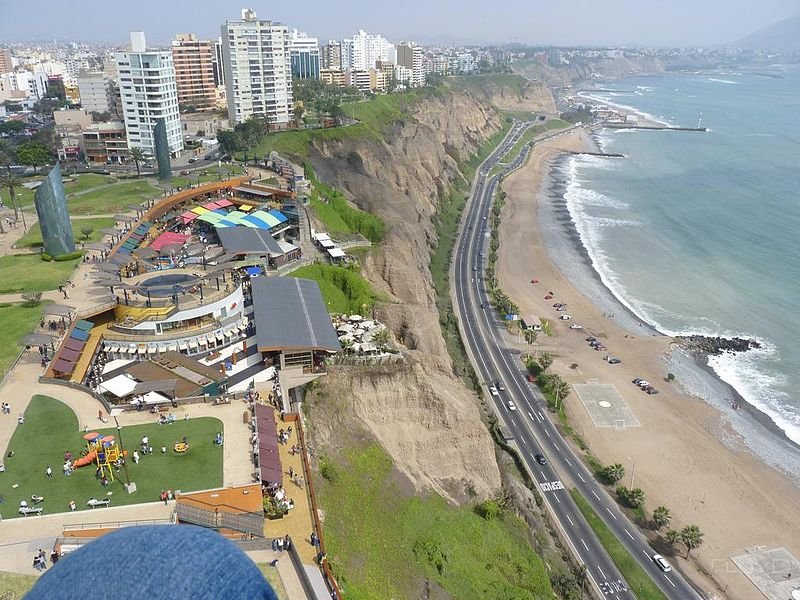 Coast of Miraflores, Lima
Coast of Miraflores, LimaSource: https://commons.wikimedia.org/wiki/File:Miraflores-Lima...jpg
Author: FLOYD

Lima was finally able to repair itself in the 1850's. New found prosperity came in the form of guano exports, and this translated into a wave of public construction projects. The Central Market was built during this period, as well as the General Slaughterhouse, the Mental Asylum, and many other buildings.
Lima suffered another round of political turbulence in the 1879-83 War of the Pacific, when it was invaded by Chile. Again it healed inself and was expanding once more from the 1890's to the 1920's. The city began to grow outwards. During this period, the La Victoria residential neighbourhood was established.
Lima was again devastated by an earthquake in 1940, but the devastation was followed by yet another round of expansion, as the city receives a new wave of immigrants from the Andes. The population grew from around 600,000 in the 1940's to 1.9 million in the 1960's and 4.8 million by 1980.
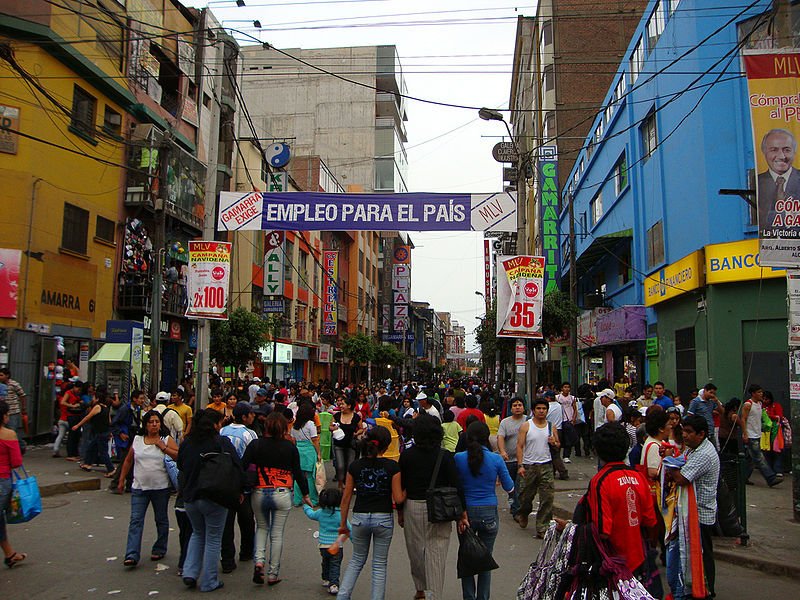 Avenida Agustín Gamarra, a shopping street in Lima
Avenida Agustín Gamarra, a shopping street in LimaSource: https://commons.wikimedia.org/wiki/File:Gamarra1.jpg
Author: Barriga

Today Lima is yet another South American capital with its share of skyscrapers as well as slums and shanty towns.
Visiting Lima, Peru
The Jorge Chavez International Airport (LIM) is the main gateway to Lima and to Peru. It receives regular flights from the major cities in Latin America as well as from Miami, Newark, Atlanta and Houston. Most of the international flights land late at night or in the wee hours of the morning. This creates a midnight chaos that make getting through customs and immigration a time-consuming experience. Arriving passengers can opt to take the airport express bus or taxi to downtown Lima. As with many cities, it is wise to book your taxi from the official desk, even though the rates may appear quite high.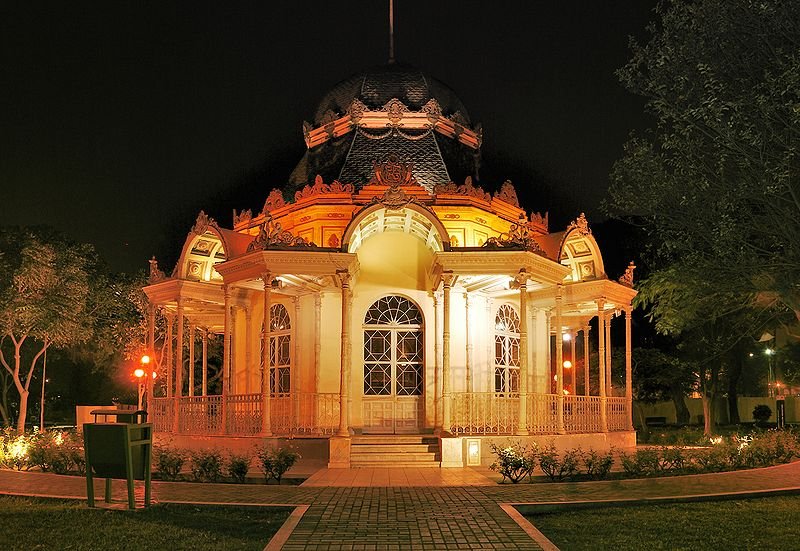 Pabellon Bizantino, Lima
Pabellon Bizantino, LimaSource: https://commons.wikimedia.org/wiki/File:Pabellon_Bizantino.jpg
Author: Martintoy

Exploring Lima
Taxis are probably the most practical option. Rides are generally not expensive, costing anywhere from US$2 to US$7. Taxis don't usually carry a meter, so you should negotiate the fare before climbing on board.Places of Interest in Lima, Peru
Central Lima- Casa de Aliaga
- Church of San Francisco
- Church of San Pedro
- Church of Santo Domingo
- Convento de los Descalzos
- La Catedral
- Las Nazarenas
- Museo de Arte
- Museo de Arte Italiano
- Museo Nacional de la Cultura Peruana
- Museo Taurino
- Palacio de Gobierno
- Plaza San Martín
- Bosque El Olivar
- Casa Ricardo Palma
- Huaca Huallamarca
- Huaca Pucllana
- Instituto Cultural Peruano Norteamericano (ICPNA)
- Larcomar
- Miraflores Clifftops
- Museo Amano
- Museo Enrico Poli
- Parque Kennedy
- La Ermita
- Museo de la Electricidad
- Museo Galeria Arte Popular de Ayacucho
- Parque Municipal
- Puente de los Suspiros
- Fortaleza del Real Felipe
- Museo Arqueológico Rafael Larco Herrera
- Museo de la Nacion
- Museo de Oro del Peru
- Museo Nacional de Arqueología
- Museo Naval del Peru
- Pachacámac
 Latest updates on Penang Travel Tips
Latest updates on Penang Travel Tips
 Discover with Timothy YouTube Channel
Discover with Timothy YouTube Channel
 PG Food Channel
PG Food Channel
 Learn Penang Hokkien YouTube Channel
Learn Penang Hokkien YouTube Channel
 SojiMart Videos
SojiMart Videos
Latest from Discover with Timothy: Gurney Bay - what to see and do there
About this website

Hello and thanks for reading this page. My name is Timothy and my hobby is in describing places so that I can share the information with the general public. My website has become the go to site for a lot of people including students, teachers, journalists, etc. whenever they seek information on places, particularly those in Malaysia and Singapore. I have been doing this since 5 January 2003, for over twenty years already. You can read about me at Discover Timothy. By now I have compiled information on thousands of places, mostly in Peninsular Malaysia and Singapore, and I continue to add more almost every day. My goal is to describe every street in every town in Malaysia and Singapore.
Robbie's Roadmap
- Episode 1: Robbie's Journey to Financial Freedom
- Episode 2: Lost in America
- Episode 3: The Value of Money
- Episode 4: The Mentor
- Episode 5: The Thing that Makes Money
- Episode 6: The walk with a Billionaire
- Episode 7: The Financial Freedom Awakening
- Episode 8: Meet Mr Washington
- Episode 9: The Pizzeria Incident
Copyright © 2003-2024 Timothy Tye. All Rights Reserved.


 Go Back
Go Back